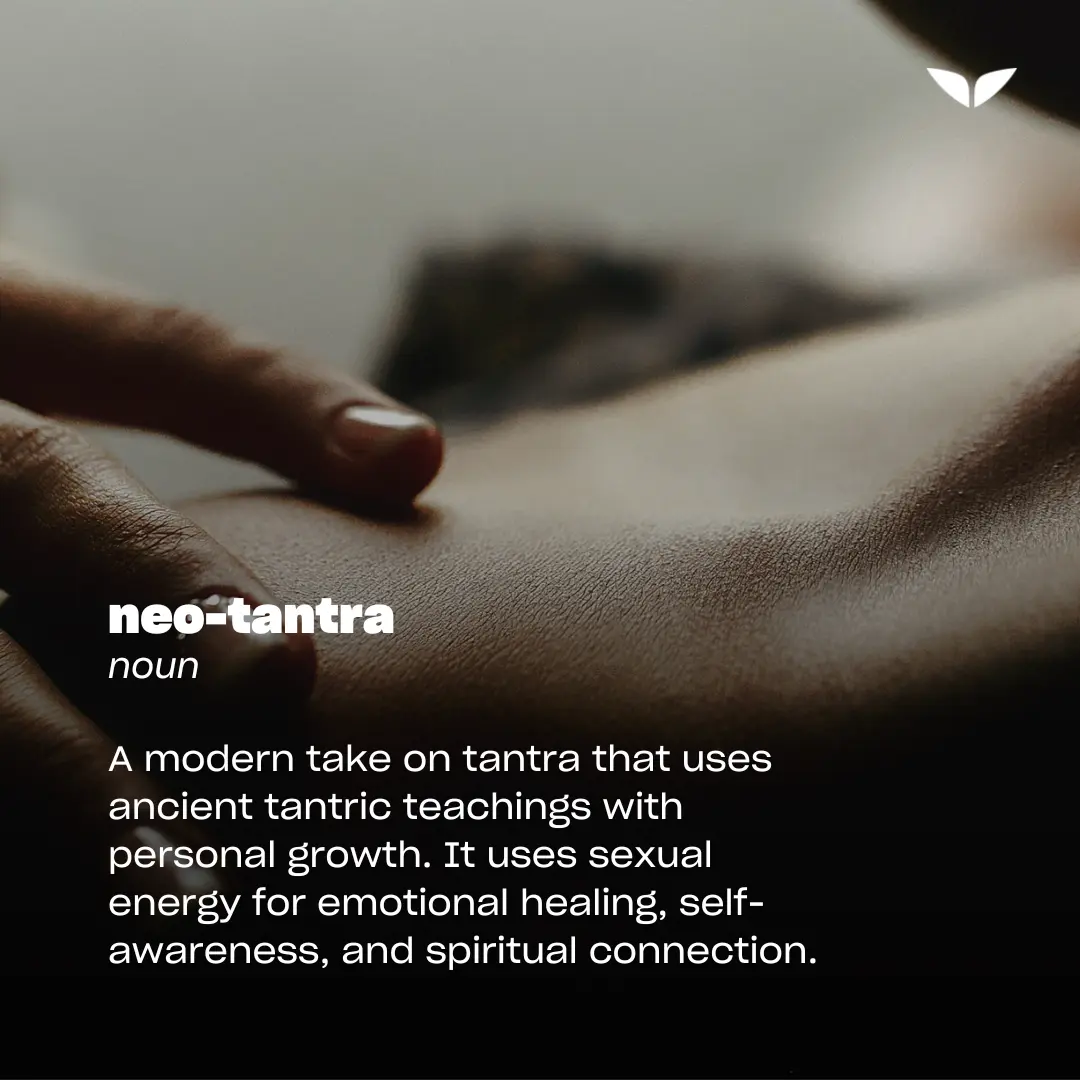Your body has been speaking to you your entire life. Every sensation, every pulse of desire, every moment of numbness—it all tells a story. No wonder it’s referred to as a “temple” in many spiritual scriptures.
Unfortunately, most of us haven’t been taught how to listen and, rather, are disconnected from this body that’s referred to as a “temple.” Neo-tantra is the practice of waking up to that story, of reclaiming the parts of yourself you’ve ignored or buried.
“This tradition, in my experience, is one of the highest, most developed, most incredible paths to spiritual awakening,” says Layla Martin, the world-renowned VITA™ Institute, in her Neo-Tantra: Discovering Energy Orgasms and Deepening Your Sexual Connection program on Mindvalley.
It’s learning to feel—really feel. To tap into your energy, your pleasure, your emotions in a way that’s raw, healing, and real.
And once you do? You’ll never experience intimacy—physical or emotional—the same way again.
What is neo-tantra?
Rooted in ancient wisdom but adapted for modern life, the “neo-tantra” meaning (with “neo-” meaning “new” or “modern”) is a practice of deep embodiment, emotional healing, and energy activation. It’s sometimes used interchangeably with “navatantra,” a term that also refers to modern tantric approaches emphasizing personal transformation, sexuality, and spiritual growth.
Margot Anand, a leading figure in the neo-tantra movement and the author of The Art of Sexual Ecstasy, played a significant role in bringing tantra into contemporary life. She helped reframe tantra from a sacred, sometimes esoteric practice to one that is more accessible and deeply rooted in personal and spiritual awakenings.
The thing is, most people hear “tantra” and think it’s just a fancier way to talk about better sex. But that’s like saying yoga is just about stretching. And according to Layla, sex and tantra are not synonymous.
“The point in real tantra isn’t to have amazing sex,” she explains. “The point is to know the truth of your being.”
And that’s what neo-tantra is out here to address. It’s a pathway to feeling fully alive in your own skin.

Why neo-tantra is more than just sex
Most of us aren’t taught what to do with that sexual energy—how to move it, heal through it, or even feel it fully.
“We’ve been taught that our sexuality is shameful and dirty or scary,” Layla explains. We’ve been conditioned to see it as an ego-driven game—one where our worth is measured by how many partners we have, how we perform, or whether we have sex at all.
But what neo-tantra does is teach you how to move sexual energy beyond just physical pleasure—channeling it into emotional release, creativity, and even spiritual growth.
The point in real tantra isn’t to have amazing sex. The point is to know the truth of your being.
— Layla Martin, trainer of Mindvalley’s Neo-Tantra: Discovering Energy Orgasms and Deepening Your Sexual Connection program
Research even shows that tantra can help people feel more connected to their bodies and emotions, ultimately leading to greater self-acceptance and healing. This could be through breathwork, movement, or conscious touch (like tantra massage, feathering, hugging, etc.).
One study, in particular, looked at women who attended tantric retreats in Northwest Europe. It found that they experienced deep changes in how they felt in their bodies, how they saw themselves, and how they connected with others.
Layla, too, went through something similar. “I not only healed very deep wounds and fears around my sexuality and began having this super incredible sex,” she recounts, “but I woke up to my full personal power.”
For Ivan Garcia, an entrepreneur from Portugal who learned neo-tantra through Layla’s Mindvalley program, the transformation was just as profound. He’s now able to experience deeper pleasure and ecstasy with his partner and “use the powerful sexual energy to rocket fuel my visualizations and manifest what I desire the most in life.”
As these people know, neo-tantra doesn’t add something new to you. It strips away what was never yours to carry. And what’s left? A version of you that feels everything, fully.
Neo-tantra vs. traditional tantra
Most people assume all tantra is the same. It’s not. So when it comes to neo-tantra vs. tantra (the traditional kind), what are the differences?
Traditional tantra
For starters, traditional tantra is an ancient path from Hinduism and Buddhism that sees the body as sacred and a key to higher consciousness. It includes practices like chanting (mantras), meditating with symbols (yantras), using hand gestures (mudras), breathwork, and energy work, often learned under the guidance of a guru.
Energy work here centers on kundalini awakening, a life force at the spine’s base. You can learn to move this energy, balance your chakras, and deepen your connection to yourself.
When it comes to sex, it’s a small part of the bigger picture. Some advanced practitioners use Maithuna, a sacred intimacy practice, to deepen their connection with energy and awareness, which often leads to a tantric orgasm.
It’s “a total mind-body-spirit connection,” as relationship expert Psalm Isadora explains. Or what she called “soul sex.” (She passed away in 2017, but her legacy continues through her Tantra Touch program on Mindvalley.)
Neo-tantra
Now, neo-tantra? It strips away the religious framework and makes tantric sex and practices more accessible. It uses breathwork, movement, and energy work to help people reconnect with their sexuality in a conscious way.
Many practices focus on harnessing sexual energy for healing, creativity, and emotional release. Some even explore energy orgasms, where pleasure moves through the body without traditional stimulation.
You may wonder, “Is tantra dangerous?” While traditional tantra was often practiced under the guidance of a guru, its modern counterpart has made these teachings more accessible through neo-tantra retreats, workshops, and programs, ensuring safety and accessibility for anyone interested in exploring it.
For a quick comparison, here’s how they stack up side by side:
| Aspect | Traditional tantra | Neo-tantra |
| Origins | Ancient spiritual path from Hinduism and Buddhism | Modern adaptation inspired by tantric teachings |
| Main Focus | Enlightenment, spiritual growth, and deep self-awareness | Healing, intimacy, and using sexual energy for personal transformation |
| Practices | Mantras, yantras, mudras, breathwork, meditation, rituals, guru guidance | Breathwork, movement, conscious touch, energy work, guided intimacy practices |
| Role of Sex | Can include Maithuna (sacred intimacy) but is a small and advanced practice | Uses sexual energy as a core part of healing and self-discovery |
| Energy Work | Focuses on Kundalini awakening and balancing chakras | Uses sexual energy for emotional healing and deeper connection |
| Accessibility | Traditionally taught by a guru and requires deep study | Available in workshops, coaching, retreats, and online programs |
| End Goal | Expanding consciousness and achieving spiritual awakening | Feeling more present, connected, and empowered in body and relationships |
How to heal your sexuality with neo-tantra
With so many people carrying shame, past wounds, or limiting beliefs, it’s no surprise that decreased sexual desire and intimacy are so common. But neo-tantra offers a way to heal.
When you start feeling your own body and sexuality as sacred, you start treating everyone else’s body and sexuality as sacred, too.
— Layla Martin, trainer of Mindvalley’s Neo-Tantra: Discovering Energy Orgasms and Deepening Your Sexual Connection program
Here are some steps, backed by Psalm and Layla, to help you embrace your sexuality fully.
1. Rewiring limiting beliefs
Your beliefs about sex, intimacy, and confidence didn’t start with you—they were shaped by your upbringing, culture, and early experiences. And without realizing it, you may still carry them in the way you express (or suppress) desire.
For many, the biggest block is shame—shame for feeling emotions, shame for wanting intimacy, or shame for not “measuring up.” Psalm explains that men, especially, are conditioned to believe they must always be strong and in control, which can make it difficult to be vulnerable or connect deeply.
One of her clients, for instance, believed his weight was the reason he couldn’t find a partner. But the real issue? His own self-doubt. He had absorbed the idea that attraction depended on appearance, not confidence. Once he let go of that belief, everything changed.
Try this
Take a moment to reflect on a limiting belief you have about yourself and intimacy. Write it down.
Now, ask yourself: Where did this belief come from? Is it really mine, or was it given to me by someone else—family, society, past experiences?
Next, reframe it into something empowering. If you’ve believed “I’m not attractive enough to be desired,” shift it to “My confidence and presence make me magnetic.”
Speak this new belief out loud or write it somewhere visible. Repeat it daily.
2. Healing past trauma
Your body remembers what your mind forgets. Trauma—whether from past relationships, childhood experiences, or cultural conditioning—doesn’t just disappear. It gets stored in your nervous system, shaping how you experience intimacy, trust, and even pleasure.
Psalm shares the story of a former NFL player who had spent his entire life bottling up anger from childhood. He had learned to suppress his emotions to survive, channeling them into his sport.
But when his body finally shut down, he realized he was carrying years of unresolved betrayal trauma. It was only through neo-tantra practices that he was able to process those emotions and release them.
Try this
Close your eyes and take a deep breath. Notice where your body feels tense, heavy, or maybe even numb.
Instead of pushing it away, breathe into that space. With each inhale, imagine creating room for release. With each exhale, let go of whatever feels stuck.
3. Embracing self-love and acceptance
Your relationship with yourself sets the foundation for every connection you have—including intimacy. But too often, people rush through life disconnected from their own desires, caught up in expectations, or stuck in self-judgment.
Neo-tantra teaches you to slow down, feel deeply, and honor what your body wants. As Psalm explains, “Tantra teaches you how to be authentic in intimacy and say what you really want, as well as being vulnerable enough to connect on a deeper level.”
This goes beyond relationships. It’s really about how you show up for yourself.
For Ivan Garcia, a student of Psalm’s, the techniques he learned gave him more confidence. Not only that, but they helped him feel closer to his partner, enjoy more pleasure, and use his sexual energy to go after his goals.
So whether it’s through mindful touch, movement, or even something as simple as savoring a piece of chocolate, practicing presence helps you reconnect with pleasure in a way that’s natural and unforced.
Try this
Take a moment to reconnect with yourself. Place a hand on your heart or your belly, close your eyes, and take a deep breath.
Now, ask yourself: What do I need right now? Maybe it’s rest, movement, touch, or simply a moment of stillness.
Whatever comes up, honor it without judgment.
4. Moving from “thinking sex” to “feeling sex”
Too often, sex becomes a performance—focused on getting to the finish line, overthinking, or trying to “do it right.” According to Layla, it’s basically approaching sex from the dorsolateral prefrontal cortex—the part of the brain responsible for planning, judging, and goal-setting.
But great sex doesn’t come from thinking. It comes from feeling.
In fact, researcher Lori Brotto found that mindfulness during intimacy significantly increases sexual desire and satisfaction. This only proves that being in the moment is key to a deeper connection.
Layla explains that in neo-tantra, this shift happens by training your nervous system to move from control to sensation. Breathwork, sound, and movement activate the medial prefrontal cortex—the part of the brain responsible for emotional connection and body awareness. And this helps you drop into the moment, making sex a full-body experience rather than a mental exercise.
“When you are deeply feeling, it doesn’t mean that you aren’t still present and able to show up for your lover,” she adds, “it just means that you are more connected to yourself and your partner as a lover.”
Try this
Next time you’re intimate, shift your focus from the end goal to the sensations in your body. Instead of thinking about what you “should” be doing, simply breathe and tune into what feels good.
Slow down, notice the textures, the warmth, and the rhythm of your movements.
5. Sound and movement
You probably already know, your body was made to move. And doing so using techniques like neo-tantra yoga can help unlock energy that’s been stuck, whether from stress, conditioning, or years of holding back. That tension, Layla explains, is often carried in the hips, pelvis, and lower body, which can dull sensation and block pleasure.
But with breath and sound, something powerful happens to uncoil it all.
“When you begin to move in combination with breath work, you can unlock the flow state of movement within you where the best sexual experiences happen,” says Layla.
However, it’s not how loud you moan or the amount of “Yes!” you can scream. Rather, it’s about expressing what’s happening inside you.
Layla describes sound as a way to move energy, shifting pleasure from being localized to spreading throughout the body. And research shows that vocalization stimulates the vagus nerve, helping to regulate the nervous system and promote relaxation.
Try this
Next time you’re alone or with a partner, move your body slowly with your breath. Let each breath guide your movements.
Don’t focus on doing it perfectly—just let the sounds and feelings come naturally. Allow your body to express what it feels.
6. Connecting with the sacred
Contrary to what many of us have been taught, sexuality isn’t separate from spirituality. Think about it: love, bliss, deep connection—these are some of life’s most powerful experiences. Why wouldn’t they be profound?
As Psalm asks, “What could be more beautiful and more sacred than two souls meeting together and making love and experiencing all this erotic pleasure?”
In the tantric tradition, your body is a temple, and pleasure is a gateway to higher states of consciousness. This perspective is at the heart of sacred sexuality.
For Emmanuel Imana, a student of Layla’s Neo-Tantra program, this form of tantra deepened his connection to the divine. “The energy that my body feels every time after the experience is just tremendous,” he shares.
Try this
Find a quiet space where you won’t be disturbed. Close your eyes, place your hands over your heart or lower belly, and take a deep breath.
As you exhale, imagine a warm, golden light filling your body, releasing any tension or shame. Silently or out loud, offer a simple blessing to yourself—something like “My body is sacred. My pleasure is sacred.”
Stay with this feeling for a few moments, letting it settle into your being. When you’re ready, open your eyes and carry this awareness with you.
7. Developing a pleasure practice
“Think of a pleasure practice like going to the gym for your sexuality,” Layla highlights. You need a dedicated space and routine to strengthen and expand your sexual experiences.
The core of a pleasure practice is to remove pressure and repetition and instead create a space where you can explore, heal, and grow. Layla found that setting aside time to focus solely on her sexual energy was key to her sexual transformation.
“If you want to have the most amazing sexual experiences and train yourself to have a full-body energy orgasm,” she explains. Through a pleasure practice, you can expand your orgasmic potential, rewire your brain to achieve multiple orgasms, and even enhance your connection with a partner.
Try this
Find a quiet, comfortable space where you feel safe. Light a candle, play soft music, or create an atmosphere that signals to your mind and body that this is your time.
Close your eyes and take slow, deep breaths, bringing your awareness to your body. Gently explore what feels good—whether it’s through touch, movement, or simply breathing into sensation without any goal.
Let go of any expectations, focus on being present with yourself, and allow yourself to awaken your inner sex goddess.
Love deeper, connect stronger
You’ve spent your whole life disconnected from your body, missing the messages it’s been sending you. Every pulse, every sensation—it’s all part of a story you’ve yet to fully embrace.
Mindvalley is here to help you hear it.
When you sign up for a free account, you’re not just getting access—you’re opening the door to a world of deep transformation. You’ll dive into exclusive lessons from top experts like Layla Martin and Psalm Isadora, offering you real, actionable tools to reclaim your body, ignite your sexual energy, and tap into your full potential.
Plus, you’ll unlock daily meditations to help you ground your newfound awareness and gain access to a thriving global community that’s on the same path of growth. It’s your chance to experience life in a whole new way—with the support, guidance, and resources to match.
So stop going through the motions and claim the power that’s always been yours.
Welcome in.









